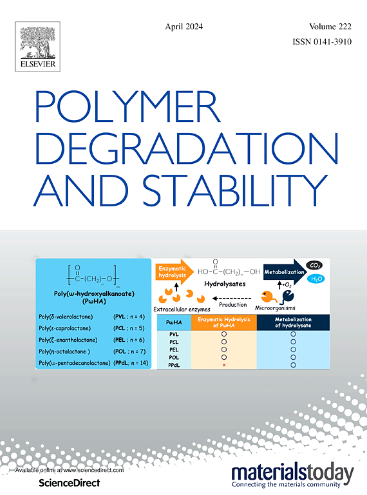The effect of carbon black on degradation of pipe grade black polyethylene in high concentration chlorine dioxide solutions
IF 6.3
2区 化学
Q1 POLYMER SCIENCE
引用次数: 0
Abstract
In this research, the impact of carbon black on the accelerated degradation of pipe grade polyethylene (PE100) exposed to high levels of chlorine dioxide (150 ppm) is examined. Tensile testing reveals a faster degradation rate in black samples compared to neat samples, indicating a detrimental effect of carbon black aggregates on the polymer's aging process. Rheological analysis shows changes in molecular weight and structure due to chemical degradation and chain scission and can be a reliable method for detecting slight changes in molecular structure. Isothermal crystallization shows a slowdown in crystallization kinetics at first, explained by gel-formation due to crosslinking which hinder the crystallization, and then an increase in the kinetics as apparently the chain scission gets dominant again. Neat samples exhibit a higher density of tie molecules, indirectly revealed by much more fibrils in crack wall observed in FESEM images, suggesting better resistance to chemical degradation while the black sample shows a much less fibrillar crack wake and becomes almost completely devoid of any fibrils at later stages of aging. The fibrils, which essentially offer a load-bearing role against the widening and growth of the crack play a key role in resistance to slow crack growth (SCG). Therefore, the higher SCG resistance is expected for neat grade compared to black samples. The study proposes a dual-layer pipe design with a UV-resistant black outer layer and an oxidation-resistant neat inner layer to prolong the lifespan of PE100 pipes by protecting against UV radiation and chemical reactions. This solution offers increased durability, lower maintenance costs, and environmental sustainability benefits.
炭黑对管道级黑色聚乙烯在高浓度二氧化氯溶液中降解的影响
本研究探讨了炭黑对暴露于高浓度二氧化氯(150 ppm)的管材级聚乙烯(PE100)加速降解的影响。拉伸测试表明,与纯样品相比,黑色样品的降解速度更快,这表明炭黑聚集体对聚合物的老化过程有不利影响。流变分析表明化学降解和链裂导致分子量和结构发生变化,是检测分子结构细微变化的可靠方法。等温结晶显示结晶动力学起初会减慢,原因是交联导致凝胶形成,阻碍了结晶,但随后动力学又会加快,因为显然链裂解又占据了主导地位。整齐的样品显示出更高的绑扎分子密度,这从 FESEM 图像中观察到的裂纹壁上更多的纤维状物可以间接看出,这表明样品具有更强的抗化学降解能力,而黑色样品显示出更少的纤维状裂纹,在老化的后期几乎完全没有任何纤维状物。纤丝主要起承重作用,防止裂纹扩大和增长,在抗慢速裂纹增长(SCG)方面起着关键作用。因此,与黑色样品相比,纯净级样品的抗慢速裂纹生长能力更强。该研究提出了一种双层管材设计,即外层为抗紫外线的黑色管材,内层为抗氧化的纯净管材,通过防止紫外线辐射和化学反应来延长聚乙烯 100 管材的使用寿命。这种解决方案可提高耐用性,降低维护成本,并有利于环境的可持续发展。
本文章由计算机程序翻译,如有差异,请以英文原文为准。
求助全文
约1分钟内获得全文
求助全文
来源期刊

Polymer Degradation and Stability
化学-高分子科学
CiteScore
10.10
自引率
10.20%
发文量
325
审稿时长
23 days
期刊介绍:
Polymer Degradation and Stability deals with the degradation reactions and their control which are a major preoccupation of practitioners of the many and diverse aspects of modern polymer technology.
Deteriorative reactions occur during processing, when polymers are subjected to heat, oxygen and mechanical stress, and during the useful life of the materials when oxygen and sunlight are the most important degradative agencies. In more specialised applications, degradation may be induced by high energy radiation, ozone, atmospheric pollutants, mechanical stress, biological action, hydrolysis and many other influences. The mechanisms of these reactions and stabilisation processes must be understood if the technology and application of polymers are to continue to advance. The reporting of investigations of this kind is therefore a major function of this journal.
However there are also new developments in polymer technology in which degradation processes find positive applications. For example, photodegradable plastics are now available, the recycling of polymeric products will become increasingly important, degradation and combustion studies are involved in the definition of the fire hazards which are associated with polymeric materials and the microelectronics industry is vitally dependent upon polymer degradation in the manufacture of its circuitry. Polymer properties may also be improved by processes like curing and grafting, the chemistry of which can be closely related to that which causes physical deterioration in other circumstances.
 求助内容:
求助内容: 应助结果提醒方式:
应助结果提醒方式:


